The Big Red One Blu-ray Movie
HomeThe Big Red One Blu-ray Movie 
Theatrical Cut & Reconstructed Version in SDWarner Bros. | 1980 | 113 min | Rated PG | May 06, 2014
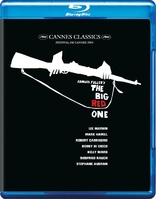
Movie rating
7 | / 10 |
Blu-ray rating
| Users | 0.5 | |
| Reviewer | 1.5 | |
| Overall | 1.5 |
Overview
The Big Red One (1980)
The story of a sergeant and the inner core members of his unit as they try to serve in and survive World War II.
Starring: Mark Hamill, Lee Marvin, Robert Carradine, Bobby Di Cicco, Kelly WardDirector: Samuel Fuller
| War | 100% |
| Drama | 7% |
| Action | Insignificant |
Specifications
Video
Video codec: MPEG-4 AVC
Video resolution: 1080p
Aspect ratio: 1.78:1
Original aspect ratio: 1.85:1
Audio
English: DTS-HD Master Audio 2.0
French: Dolby Digital Mono
German: Dolby Digital Mono
Italian: Dolby Digital Mono
Spanish: Dolby Digital 2.0
Portuguese: Dolby Digital Mono
Theatrical cut
Subtitles
English SDH, French, German SDH, Italian SDH, Portuguese, Spanish
Discs
50GB Blu-ray Disc
Single disc (1 BD)
Playback
Region A, B (C untested)
Review
Rating summary
| Movie | 4.0 | |
| Video | 2.5 | |
| Audio | 3.0 | |
| Extras | 4.5 | |
| Overall | 1.5 |
The Big Red One Blu-ray Movie Review
The Big Blu Bust
Reviewed by Michael Reuben May 10, 2014Rarely has a Blu-ray disc promised so much and delivered so little as Warner's edition of The Big Red One (hereafter, "TBR1"). Long regarded as the crowning masterpiece of legendary writer/director Sam Fuller, the 1980 epic tale of four soldiers and their sergeant in World War II was taken out of Fuller's hands by the production company, Lorimar, and trimmed by almost an hour before its release. (The rumored four-hour director's cut is an urban legend, for reasons explained by the commentary accompanying the film.) Not until 2004, seven years after Fuller's death, was an attempt made at reconstituting the film according to the director's shooting script. The resulting "reconstructed" version is generally acknowledged to be a far superior product that more accurately represents Fuller's vision. The Blu-ray extras contain a nearly hour-length documentary on the reconstruction, a commentary on the reconstructed version by critic and film historian Richard Schickel, who oversaw the project, and the trailer for its theatrical release. But what has Warner included in high definition? Only the bastardized theatrical release created by Lorimar. The superior reconstructed version is provided in standard definition. If you already own the two-disc "Special Edition" DVD released by Warner in 2005, keep it and move along. There's nothing more to see here. Substantial discussion in the Blu-ray.com forums and elsewhere has led to the following explanation for this bizarre omission: The reconstruction of TBR1 was reportedly edited on standard definition video and therefore exists only in that format. As the trailer for the reconstruction suggests, it played theatrically (a fact confirmed by reliable sources such as the database maintained by Turner Classic Movies), but the 35mm prints were sourced from SD DigiBeta tape. One source affiliated with Warner has attempted to suggest that the reconstruction producers were not "looking toward the future", but the more likely explanation was that they were making the most of the limited budget that Warner allotted for the project. Still, Warner should be perfectly capable of creating an HD version of the reconstruction, if it wished to do so. As the restoration documentary and commentary included with the Blu-ray make clear, the work was performed from negatives and other high-quality sources that presumably still exist. The editorial decisions have already been made, and the new soundtrack has already been created. All that would be required is to follow the roadmap laid down in 2004. With the improvements in scanning and digital repair technology in the years since then, the results would be well worth the effort, especially since the presentation of the theatrical cut on Blu-ray is so weak. Here again, it's all a matter of what Warner was willing to invest in the presentation of a major entry in its library. I don't need to wait until the end of this review to recommend against buying this Blu-ray. TBR1 makes an impression, even in its truncated form, but Warner owes both the film's fans and cinema history a proper release of the reconstruction. I suggest writing a polite (repeat: polite) letter to the company requesting that the reconstructed version be given a genuine HD release on Blu-ray. In the meantime, you may as well save a few dollars and buy the DVD.
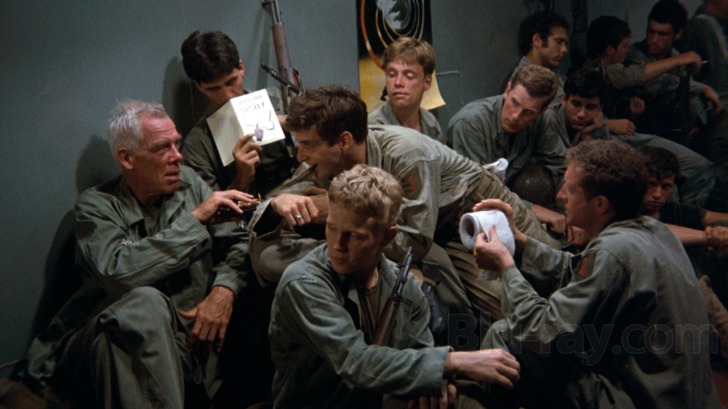
All screen captures are from the THEATRICAL version.
"The Big Red One" is the nickname of the infantry unit in which Fuller served in the European theater of World War II. The film is a semi-autobiographical account of his experiences, shaped by elemental themes reflecting everything Fuller learned from these formative years: War is not heroic. Death is sudden, merciless and unexpected. A soldier's only "glory" is to out-survive the enemy. The film opens with a black-and-white sequence set at the end of World War I, which shows how a lone private (Lee Marvin) created the unit's nickname. On the final day of hostilities, the private kills a German soldier under circumstances that trouble him for the rest of his life, because they violate his personal code of conduct. The incident resonates throughout the film. A career soldier, Marvin's character is so much a part of the Army that he is never identified by name. (He calls himself "Possum" in a radio transmission, but it's an obvious code.) John Wayne sought the role, but Fuller specifically wanted Marvin for his gaunt face and haunted eyes. As Fuller would later say, Marvin looked like death itself. TBR1 then dissolves to color and jumps forward 35 years, when the private is now a sergeant (known simply as "Sergeant") commanding a unit that includes four soldiers who come to be called "the Four Horsemen" because of their miraculous ability to survive battle after battle. The luck of these four is partly a narrative strategy, because the story needs characters who can provide continuity, but it also becomes part of Fuller's running commentary on the randomness of death in battle. Expendable newcomers enter the story, introduce themselves and stay for one scene or maybe longer, before they are abruptly cut down, leaving the Sergeant and his Four Horsemen. The four are: Zab (Robert Carradine), a budding writer or, as he calls himself in his narration, "the Hemingway of the Bronx"; Griff (Mark Hamill), an aspiring artist; Vinci or "Vince" (Bobby De Cicco), a street kid and sax player, whose Italian-speaking Sicilian heritage will prove useful; and Johnson (Kelly Ward), a farm boy. Zab, who is always chomping on a cigar, is the obvious stand-in for Fuller himself, but according to the director's daughter, each of the Four Horsemen represents some aspect of Fuller's character, even the sensitive Griff, whose struggles with his reluctance to kill another human leave his comrades wondering whether he's a coward (though they hesitate to say it out loud). Griff's qualms play out over the entire film, and they parallel the Sergeant's regret over his actions on the last day of World War I. The interplay between these two soldiers of different backgrounds and generations draws out deep moral questions from what, on the surface, appears to be a raw tale of kill-or-be-killed. Working mostly in Israel with a relatively small number of extras and military equipment, Fuller recreates his former unit's major engagements with such inventive camerawork and editing that TBR1 feels much bigger than its minuscule budget (about $4 million, which, even in 1980, was almost nothing for a major war film). As the Sergeant and his Four Horsemen dodge tanks in North Africa, clear out village after village in Sicily, storm Omaha beach on D-Day (a sequence that Steven Spielberg must have studied for Saving Private Ryan), and push on into France and Belgium, they face the enemy in all kinds of confrontations. The engagements range from German soldiers who make the mistake of running for shelter into a cave where the Sergeant and his men were already hiding—and are efficiently bayoneted—to gunners manning a camouflaged cannon atop a Sicilian hill, who have to be stalked and ambushed from behind. (In a classic Fuller touch, the Sergeant and his men are led to the concealed gunnery installation by a local boy, now an orphan, who is dragging his mother's body behind him in a cart, but only after he makes them promise that they will get him a coffin, with handles, in which to give her a proper burial.) Fuller is deliberate in his efforts to imbue his portrayal of war with a sense of madness, but that doesn't make TBR1 a satire. In Fuller's vision, madness is simply part of war's reality, a result of the bizarre collisions of events that arise out of chaos. In an eerie moment, the Sergeant recognizes that his unit is approaching the exact spot where, many years ago, he experienced the events of the opening B&W sequence. Now, however, it has become the site of a German ambush that only the Sergeant's experienced eye detects before they are caught completely off guard. Before the squad can catch their breath from that harrowing encounter, they find a pregnant Frenchwoman who has gone into labor, and the Sergeant orders Pvt. Johnson to deliver the baby, because he trained as a medic. Add in the language barrier, and the scene takes on unexpected comic overtones, but Fuller also gets across his underlying point: A soldier never know what's coming next. TBR1 reaches its conclusion in Czechoslovakia with the liberation of the concentration camp at Falkenau. Here again, Fuller's skill at suggesting more than he shows is masterly. Leaving aside questions of expense, a recreation of real concentration camp footage would not have the same impact as the expressions on the faces of the Sergeant and the Four Horsemen, as they confront, for the first time, the full horror of the enemy they have been fighting. It is here that both Griff's and the Sergeant's battles with their inner demons achieve a resolution (as much as such battles can ever be resolved). In writing this overview, I have tried to confine myself to elements that exist in the 113-minute theatrical cut, since that is what has been provided in high-def. That version has enough strength to have acquired a loyal fan base, but even as you're watching it, you can tell that something is "off". The pacing is choppy; sequences end before their time; logistics are sometimes muddy; and there's a strong sense that some of the character development is missing. The 163-minute reconstructed version restores whole sequences, as well as individual shots that make the existing scenes clearer. It also comes with an enhanced and remixed soundtrack built on top of the original mix that preserves its integrity. I look forward to reviewing it on Blu-ray someday.
The Big Red One Blu-ray Movie, Video Quality 
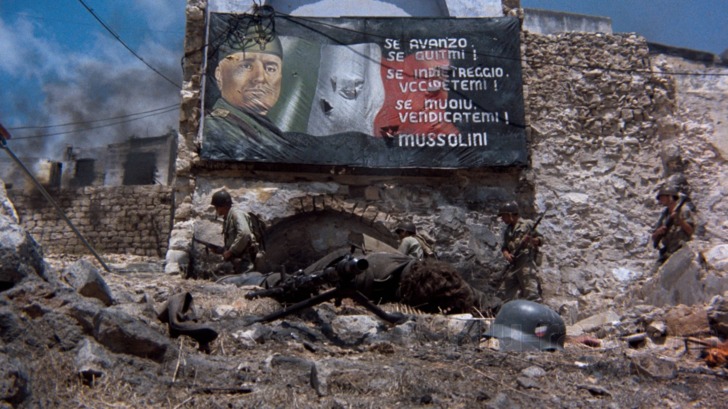
Polish-born cinematographer Adam Greenberg shot The Big Red One in the era when he was still working in Europe; a few years later, he would relocate to America and establish a reputation on such films as The Terminator, Terminator 2: Judgment Day, Rush Hour and Eraser. Greenberg is known for deep blacks and strong cyans, but you'd never know that from Warner's 1080p, AVC-encoded presentation of the theatrical cut of TBR1, which adds insult to injury with a flat, dull and underwhelming image. Colors are washed out, detail is erratic, blacks are weak and the grain pattern looks suspiciously scrubbed, especially for a film that is supposed to have a raw and gritty immediacy. Colors are somewhat more vivid in specific sequences, notably the Sicily engagements and the Moroccan coast, where blue skies and beautiful flowers are meant to contrast with battle smoke and demolished buildings, but the entire presentation has the look of a transfer prepared for smaller screens, NTSC resolution and a limited color space. Certainly the image is better than DVD, but I wouldn't call it "film-like". The average bitrate for the theatrical cut is 19.92 Mbps, which is on the low side. Then again, when an image looks more like video than film, as so much of this one does, it usually compresses more easily.
The Big Red One Blu-ray Movie, Audio Quality 
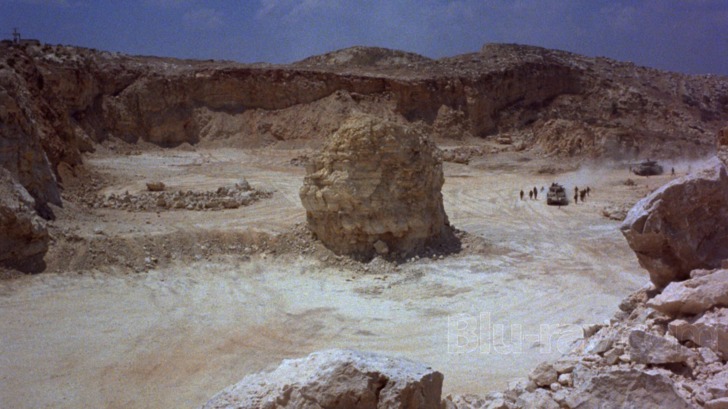
TBR1 was released in Dolby Stereo, which is here reproduced in lossless DTS-HD MA 2.0. It's an adequate but underwhelming track that reflects the film's budgetary limitations even more than its era. Gunfire and explosions have no real impact, even though the film involves tanks and heavy artillery. The score by Dana Kaproff sounds thin and compressed. The dialogue is certainly comprehensible, but it has little to compete with it. Judging from the description in the reconstruction documentary, the Blu-ray track accurately reproduces the source with all its limitations. What's galling is that the reconstructed version received a complete sonic overhaul that preserved the original's character but extended its dynamics and took advantage of the 5.1 array. No such option has been created for the theatrical version.
The Big Red One Blu-ray Movie, Special Features and Extras 
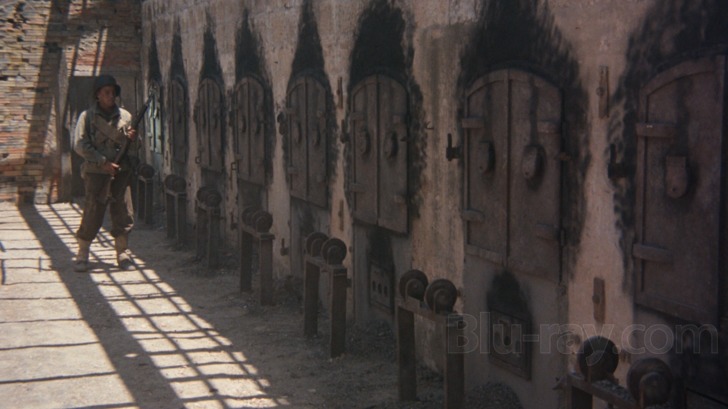
Warner first released TBR1 on DVD in its theatrical cut in 1999, accompanied only by theatrical notes. On Blu-ray, the extras have been ported over from Warner's two-disc 2005 "special edition" DVD release of the reconstructed version. Only the stills gallery from the special edition has been omitted. The Blu-ray also uses the same cover art as the special edition.
- Commentary with Reconstruction Producer Richard Schickel (Reconstructed Version): Schickel's commentary is an invaluable guide to the scenes and sequences that were added back in the reconstruction, as well as an insight into the thinking behind the choices made by Schickel and editor Bryan McKenzie. From both his personal acquaintance with Fuller and his detailed familiarity with the director's body of work, Schickel supplies useful insights into recurrent themes and, especially in the film's conclusion, reflects on the challenging questions with which Fuller leaves the audience.
- The Men Who Made the Movies: Sam Fuller (480i; 1.33:1; 55:02): Written, produced and directed by Schickel and narrated by Sydney Pollack, this biographical documentary was made for Turner Classic Movies. It features rare, exclusive interview footage with the director himself and excerpts from many of his films, providing an informative overview of his entire career.
- The Real Glory: Reconstructing The Big Red One (480i; 1.33:1; 47:24): Featuring interviews with Hamill, Carradine, De Cicco, Lang and Schickel, this documentary covers, first, the making of the film and, second, its reconstruction by Schickel, editor Bryan McKenzie and restoration expert Brian Hamblin. The director's daughter, Samantha Fuller, also participates.
- The Fighting First: A War Department Film (480i; 1.33:1; 12:17): This is an official account of the unit in which Fuller fought during World War II and depicted in The Big Red One. Compare the documentary's account to Fuller's film, and it becomes clear how directly his script drew from history.
- Anatomy of a Scene (480; 1.33:1; 18:31): A "play all" function is included. Although it is nowhere noted on the menu, these scenes come with two audio tracks. One is the original audio, and the other provides commentary with editor Bryan McKenzie and reconstruction supervisor Brian Hamblin. The separate tracks must be selected manually from your player's audio menu.
- Sam Directs: Squad Sleeps
- Sam Directs: General Tavernier
- Amphitheatre: Before Restoration
- Amphitheatre: After Restoration
- Tank Baby: Before Restoration
- Tank Baby: After Restoration
- Deleted Scenes (480i; 1.33:1; 32:11): A "play all" function is included. Although it is nowhere noted on the menu, these scenes also come with two audio tracks, the original audio, and the other with commentary by Bryan McKenzie and Brian Hamblin. The separate tracks must be selected manually from your player's audio menu.
- Battle Reservations
- Vichy French
- Minnow's Death
- Zig Zag (Lift)
- Sandstorm
- Airborne
- Shep's Death
- On Patrol (Alternate)
- Vinci's Grandmother
- Dopplegangers
- Belgian's Underground
- Palm Trees?
- Rensonnet's Plea?
- Bulge Infiltrator
- Schnapps (Lift)
- Samantha Fuller
- Barney
- War Is Over (Extended)
- Promo Reel (480i; 1.33:1; 29:56): This collection of scenes, introduced by Lee Marvin, was discovered in 1999 and provided the first clue that missing footage from the film still existed.
- Radio Spots (audio only).
- The Critics Applaud (0:31)
- A New Classic (0:28)
- TV Spots (480i; 1.33:1).
- Fuller's Story (0:34)
- Sergeant (0:33)
- 2004 Trailer (480i; 1.85:1, non-enhanced; 2:20). "It was the right thing to do", brags Warner in this trailer. "The seminal war movie of its time has returned . . . as director Sam Fuller originally intended." Just not on hi-def Blu-ray.
The Big Red One Blu-ray Movie, Overall Score and Recommendation 
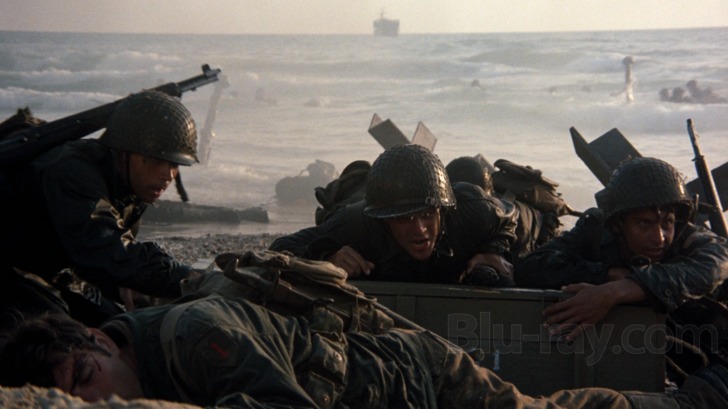
The Big Red One is a great war film, but if you're going to buy this Blu-ray version, you should know what you're getting. First, you're getting a weak HD presentation of the studio-edited theatrical cut that was a major disappointment to both the writer/director and his cast. Second, you're getting the 2005 two-disc DVD special edition of the reconstructed version, entirely in standard definition but on a Blu-ray disc. Most of the extras from that edition will tell you that the theatrical cut isn't worth your time, even though that's the only item in high-definition on the Blu-ray. As I suggested in the introduction, save a few dollars and buy the DVD. If nothing else, a surge in sales of the reconstruction DVD may demonstrate to Warner that there's genuine interest in that version.
Similar titles
Similar titles you might also like

Cross of Iron
1977

The Dirty Dozen
1967

The Longest Day
1962

'71
2014

The Young Lions
Limited Edition to 3000 - SOLD OUT
1958

Anzio
1968

To Hell and Back
1955

Ice Cold in Alex
1958

Rescue Dawn
2006

5 Days of War
2011

Hell Is for Heroes
1962

Fury
2014

Dunkirk
1958

Dunkirk
2017

The Wild Geese
1978

The Bridges at Toko-Ri
1954

A Walk in the Sun
1945

Gallipoli
1981

Tobruk
1967

Flight of the Intruder
1991